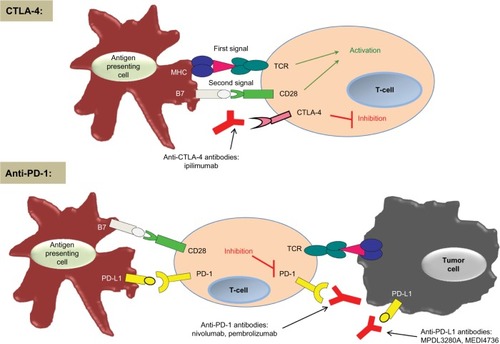Figures & data
Figure 1 Simplified concept of CTLA-4 and PD-1 immune checkpoints.
Notes: In the priming phase, antigen-presenting cells present antigens to the T-cell. Two signals are required to initiate a T-cell response. CTLA-4 is upregulated after T-cell activation and inhibits the T-cell response. Anti-CTLA-4 antibodies bind to CTLA-4, turning off the ‘inhibitory signal’, thus resulting in an enhancement of T-cell function. In the effector phase, the PD-1 inhibitory receptor is expressed by the T-cell and, when it is engaged by its ligands PD-L1 and PD-L2, it serves to inhibit the T-cell response. Anti-PD-1 antibodies bind to PD-1, turning off the ‘inhibitory signal’ in the peripheral tissues and enhancing T-cell function. PD-1/PD-L1 interactions are complex, and this interaction is also involved in the priming phase. We have chosen to portray the main concepts for both of these immunologic checkpoints in this figure for simplicity.
Abbreviations: CD, cluster of differentiation; CTLA, cytotoxic T-lymphocyte-associated antigen; MHC, major histocompatibility complex; PD, programmed cell death; TCR, T-cell receptor.
Abbreviations: CD, cluster of differentiation; CTLA, cytotoxic T-lymphocyte-associated antigen; MHC, major histocompatibility complex; PD, programmed cell death; TCR, T-cell receptor.

Table 1 PD-1 and PD-L1 therapeutic agents in clinical developmentTable Footnotea
